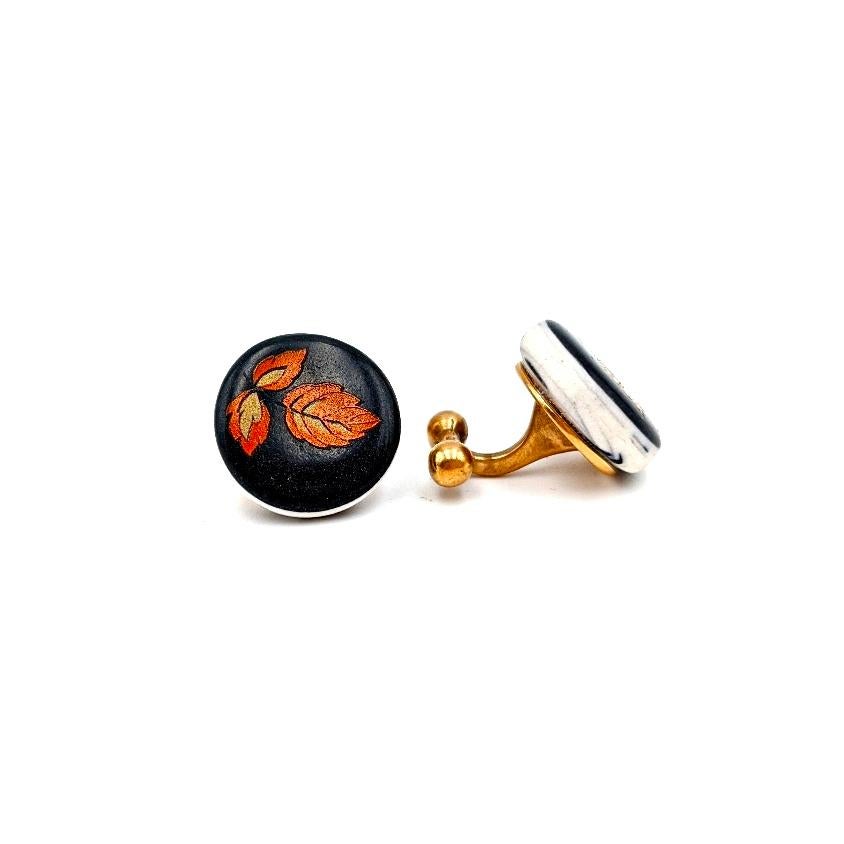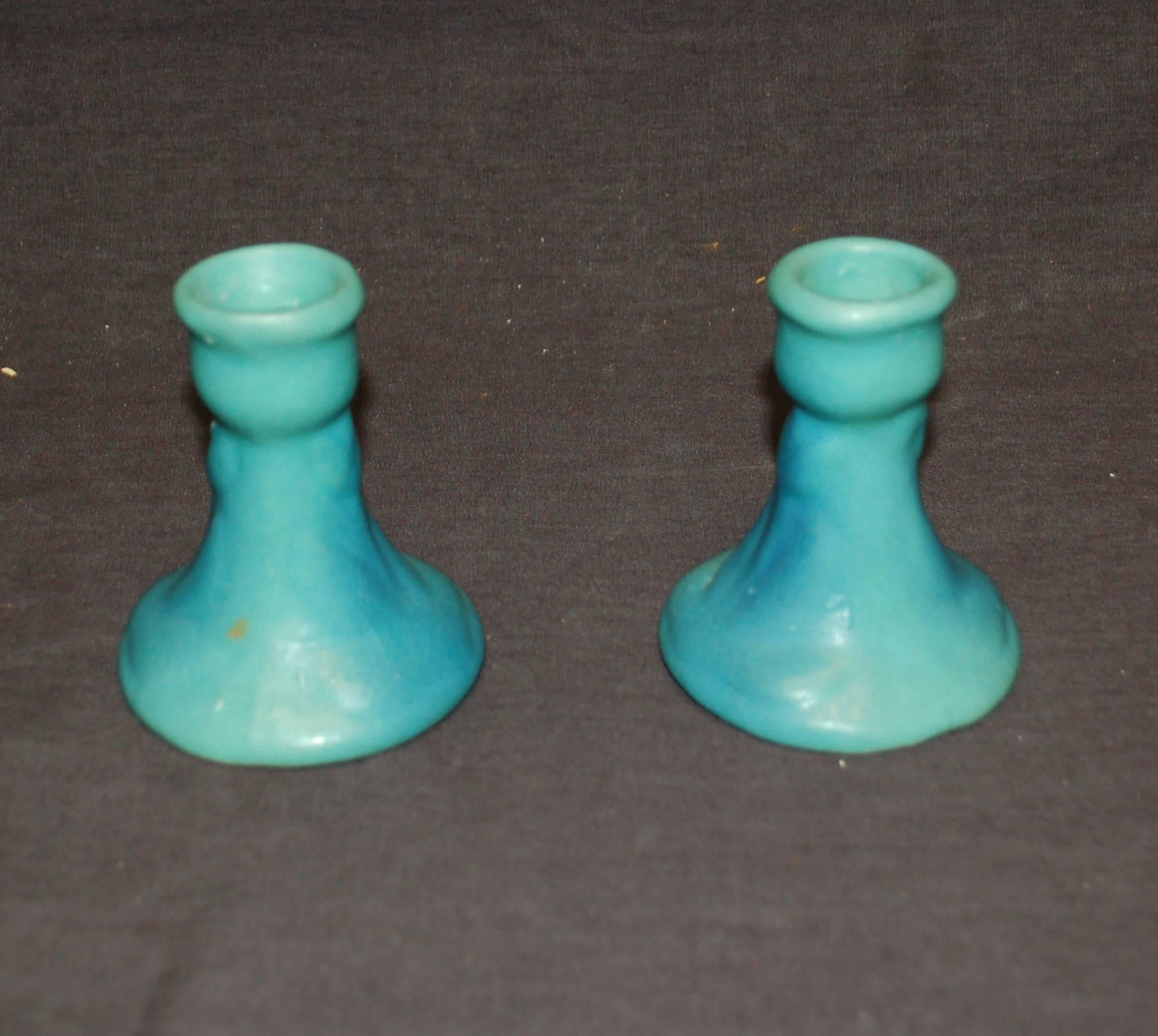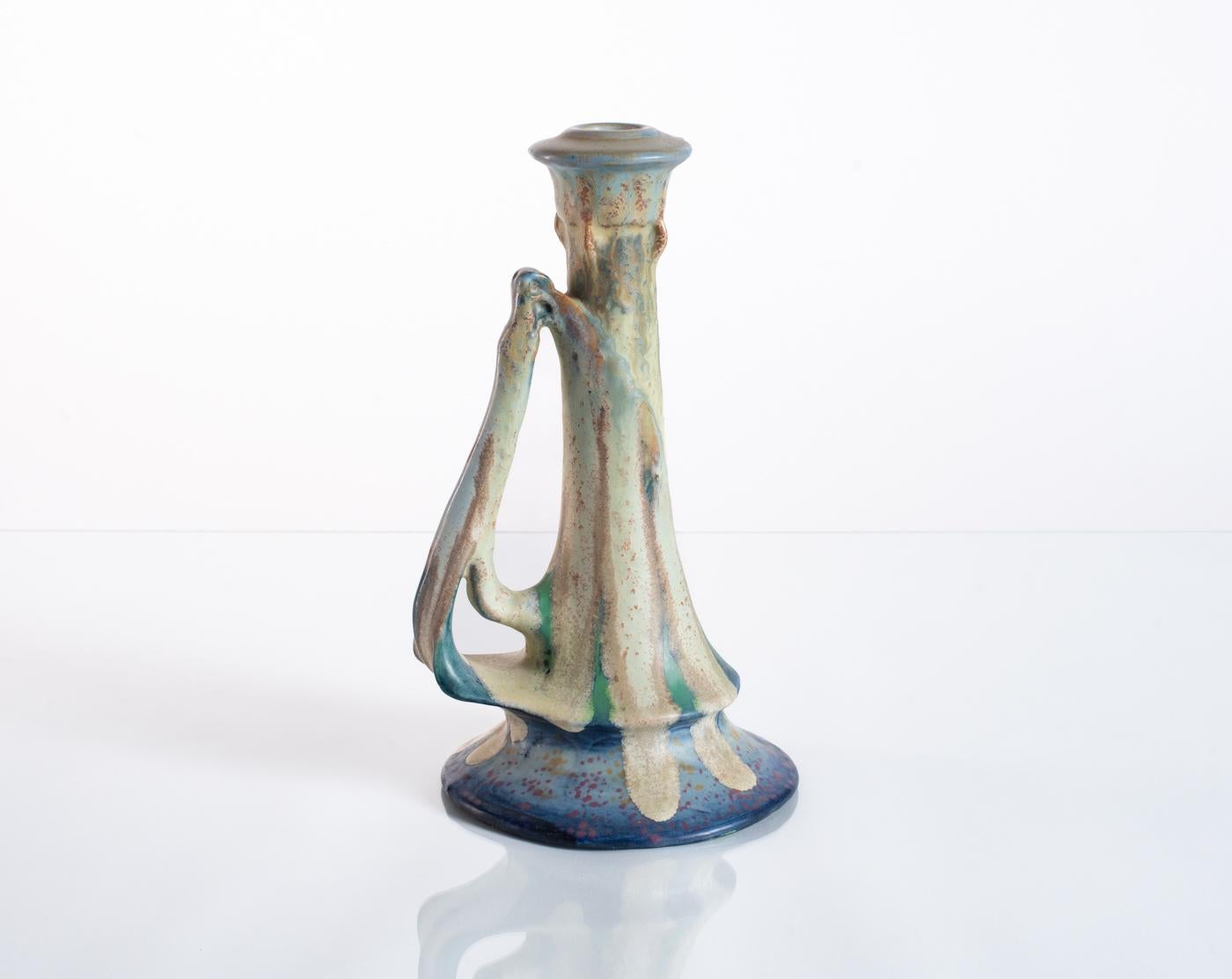Items Similar to Bohemian Flux Vase
Want more images or videos?
Request additional images or videos from the seller
kuk Fachschule fur Keramik und Verwandte KunstgewerbeBohemian Flux Vasec. 1905
c. 1905
About the Item
BOHEMIAN FLUX: A VASE, kuk Fachschule für Keramik und Verwandte Kunstgewerbe, Turn-Teplitz, c. 1905; the ceramic vase with a dark underglaze ground has a matte orange peel overglaze in ochre, apricot, lapis and celadon; the shape of the vase resembles a Japanese Saki bottle with the addition of four long and slender handles at the top third; incised before firing on the base in script lettering,“P.W.”, stamped before firing with the Fachschule mark and 73, and marked “G2.” in black ink; the vase measures: 13” high.
Flux- continuous moving, a glazing method, fusion- the artist who produced this remarkable vase has presented a profoundly poetic and technical meditation on this subject. Moving way beyond the pursuit of creating only functional objects, the student ceramists at Fachschule Teplitz had ingrained in them the Europeans’ fascination for Japanese objects “from the floating world” and the design aesthetic known as Japonisme. Truly modern interpretations of Japonisme had begun to evolve into an internalizing of the aesthetic principles and a shift away from imitation of Japanese style applied to a Western format. This vase is noteworthy in that it illustrates this important Modernist shift in European ceramics. The elements of the saki bottle can be divided into three key components which taken as a whole create a rather feminine line. In keeping with this approach, the Fachschule student presents a slender bare neck, like décolletage, which flares ever slightly and then narrows to a high waist before voluptuously widening down and terminating gracefully to a round base. The ceramist gives special emphasis to pleasing proportions and the complementary relationship to the number 3; the measurement at the widest section of the vase equals the same distance from that point up to where the bottoms of the handles join to the body of the vase as well as the full arms’ length. Instead of inscribing the vase with Japanese calligraphy denoting a saki shop, the student takes a radically modern approach by attaching the vase with four handles. And yet, this act is every bit a form of written identification. The arms are the embodiment of the idea of flux in that they are a substance applied to a surface by the welding together to promote their union. The handles serve a new and surprising function. They are carriers of a concept. Fluidity- flux -can be created when an artist joins disparate elements into a harmonious whole.
Flux is also a substance used to promote the fusion of minerals and metals and a term describing ceramic glazing. The presence of silica in glazes creates a glassy finish when fired at high temperatures. Matte glazes result from the presence of crystals under the surface and the balance between silica, flux and alumina in the glaze materials. By deliberately under-firing this vase and playing with a combination of additives forming the flux glaze, the end result appears matte and textured. The orange peel quality and alluring color palette are transformative. The effect evokes a waterfall or another continuous moving flow of water like a stream - in flux.
So not only does this artist take a Meiji Period saki bottle and the aesthetic tenets of Japonisme as the formal and theoretical points of departure, the artist infuses the work with the symbolism of skill itself where artistic mastery as the embodiment of flux becomes the subject to ponder. As a fully realized and beautifully rendered piece, the vase attests to the artistic prowess of its creator. No longer a mere student working in the shadows of the teacher and no longer simply imitating or replicating past styles, this emerging artist shows the complete fluid transfer from student to master ceramist. Seen in this light, the vase represents a significant and pivotal achievement in Modern European ceramic ware.
Fachschule für Keramik und Verwandte Kunstgewerbe (the Imperial School for Ceramics and Associated Applied Arts, 1875-1917) was a powerhouse of the ceramics industry. Located in the Turn-Teplitz region of Bohemia near the German border of what is today The Czech Republic, this was Europe’s largest pottery center in the first part of the 20th century. The school played an integral role in the center’s internationally regarded success as it provided the foundation of sourcing and training new talent for noted local manufacturers such as Amphora. It was at the Fachschule that master artists from these local ceramics houses enjoyed teaching and lecturing posts, and in true synergistic spirit, the big ceramics houses in turn supplied the school with raw material such as clay and glazing minerals. Much more than a school, the Fachschule für Keramic in Turn-Teplitz was a hotbed of creative activity which produced masterful works on par with their commercial peers. Fachschule Teplitz’s inclusion at l’Exposition Universelle in Paris in 1900 and at the World’s Fair held in St. Louis in 1904, at the zenith of this region’s ceramic output, illustrates to what high degree it was esteemed among the art world.
- Creator:kuk Fachschule fur Keramik und Verwandte Kunstgewerbe (1875 - 1917)
- Creation Year:c. 1905
- Dimensions:Height: 13 in (33.02 cm)Width: 7.5 in (19.05 cm)
- Medium:
- Movement & Style:
- Period:
- Condition:
- Gallery Location:Chicago, IL
- Reference Number:1stDibs: LU46736549882

About the Seller
5.0
Gold Seller
These expertly vetted sellers are highly rated and consistently exceed customer expectations.
Established in 2013
1stDibs seller since 2016
84 sales on 1stDibs
Typical response time: 2 hours
- ShippingRetrieving quote...Ships From: Chicago, IL
- Return PolicyA return for this item may be initiated within 3 days of delivery.
More From This SellerView All
- Reverie Charger by Lucien Levy-Dhurmer for Clement MassierBy Lucien Levy-DhurmerLocated in Chicago, ILKnown today as a Symbolist painter, Lucien Lévy-Dhurmer made an unforgettable impact on France's ceramic revolution through his work with Clément Massier in Golfe-Juan between 1887 a...Category
Early 1900s Art Nouveau More Art
MaterialsEarthenware, Luster
- Female Relief PlaqueBy Henri CrosLocated in Chicago, ILHENRI CROS (1840-1907) Female Relief Plaque, polychrome enameled stoneware, c. 1895; signed in black ink verso: “H. Cros”, and a scrap of paper from A.A. Hebrard, Paris attached verso; measuring h: 11.25 x w: 9.38 inches. The symbolist bust in relief of a nude young woman with strawberry blonde hair is a depiction of pensive reverie. With lips slightly pursed, she is lost in thought, looking inward. The female visage hovering just over the nude’s shoulder, perhaps an allusion to a fountain, is by contrast flat and lifeless. With lips parted to reveal a watery blue orifice and wavy tresses of hair blending into a watery expanse, the purely decorative nature of the fountain’s face...Category
1890s Art Nouveau Figurative Sculptures
MaterialsStoneware, Glaze
- Flirt (Biscuits Lefevre-Utile) Lithograph PosterBy Alphonse MuchaLocated in Chicago, ILAlphonse Mucha was a painter and decorative artist best known for the sensual Art Nouveau paintings, posters, and advertisements that came to define Art Nouveau in fin de siècle Pari...Category
Early 1900s Art Nouveau More Art
MaterialsLithograph
- The JockeyBy Henri de Toulouse-LautrecLocated in Chicago, ILColor lithograph on Chine volant, 1899. Edition of aproximately 112. Printed by H. Stern, Paris. Published by Pierrefort, Paris. Reference: Wittrock; 308-2nd edition, vol. 2, pg. 6...Category
1890s Art Nouveau Figurative Prints
MaterialsLithograph
- "Princess Hyacinthe" Original 1911 Lithograph, Alphonse MuchaBy Alphonse MuchaLocated in Chicago, IL“One of Mucha’s best Czech posters, printed by the firm of V. Neubert in the Smichov quarter of Prague, was for Princezna Hyacinta, a fairy-tale ballet and pantomime with music by Oskar Nedbal and libretto by Ladislav Novák. The portrait of the popular actress Andula Sedlácková as the princess dominates the poster. The plot develops as a dream of a village blacksmith who falls asleep after digging for a buried treasure. In his dreams he becomes lord of a castle, and his daughter Hanicka becomes the Princess Hyacinth. Of her three suitors, one is a sorcerer who abducts her to his underground palace, but she is rescued by a poor knight who looks like her real-life lover. Mucha used the motif of the hyacinth throughout the entire design, from embroideries to silver jewelry, and for an elaborate circle sparkling against the mossy green background. The portrait of the actress is seen against a sky full of stars and encircled with images from the dream: the blacksmith’s tools...Category
1910s Art Nouveau Figurative Prints
MaterialsLithograph
- "Bénédictine" Original 1898 Lithograph, Alphonse MuchaBy Alphonse MuchaLocated in Chicago, ILPublished by F. Champenois, Paris. "Bénédictine shows two girls pressing flowers amid book leaves, to remind us of the herbs that go into making the liqueur; the bottom part of the poster has a panorama of the Fecamp Abbey where the drink originated. Around 1510, one of the monks, Dom Bernardo Vincelli, prepared a liqueur using local wine and native herbs found in nearby woods, together with a few imported ingredients including muscat, ginger, clove and cardamom" (Wine Spectator, 70). As with all poster this size, the lithograph was made, in color, on two panels and joined at the center. Alphonse Mucha was a painter and decorative artist best known for the sensual Art...Category
1890s Art Nouveau Figurative Prints
MaterialsLithograph
You May Also Like
- Cufflinks Red Gold Flower Vintage Black Porcelain Jewelry Men (MADE TO ORDER)By Melanie ShermanLocated in Kansas City, MOMelanie Sherman Cufflinks with Red & Gold Flowers on Black Porcelain Dimensions: 20mm x 17mm x 17mm Materials: Porcelain, Glaze, Vintage Decal Metal type: Brass COA Provided * These pieces are made to order any may exceed the 10 Day Shipping time frame Melanie Sherman is a ceramic artist, born in Germany and currently residing and working in Kansas City, Missouri. She has a Bachelor of Fine Arts Degree in ceramics from the Kansas City Art Institute. Her background is in graphic design, where she developed an eye for pattern and decoration. In her ceramics she combines her love for ornamentation and her fascination with the history of ceramics, referencing 18th century European porcelain...Category
2010s Art Nouveau More Art
MaterialsGold, Brass
- Cufflinks Red Gold Flower Vintage Black Porcelain Jewelry Men (MADE TO ORDER)By Melanie ShermanLocated in Kansas City, MOMelanie Sherman Cufflinks with Red & Gold Flowers on Black Porcelain Dimensions: 20mm x 17mm x 17mm Materials: Porcelain, Glaze, Vintage Decal Metal type: Brass COA Provided Melanie Sherman is a ceramic artist, born in Germany and currently residing and working in Kansas City, Missouri. She has a Bachelor of Fine Arts Degree in ceramics from the Kansas City Art Institute. Her background is in graphic design, where she developed an eye for pattern and decoration. In her ceramics she combines her love for ornamentation and her fascination with the history of ceramics, referencing 18th century European porcelain...Category
2010s Art Nouveau More Art
MaterialsGold, Brass
- Pair of Blue/Green Candle HoldersBy Van BriggleLocated in Missouri, MOIn 1899, when Artus Van Briggle stepped off the train in Colorado Springs he must have felt worlds away from the studios of Paris and the landscapes of Italy where his extraordinary ...Category
1950s Art Nouveau More Art
MaterialsCeramic
- Amphora Mystical Art Nouveau Ceramic Candelstick World’s Fair 1900Located in Chicago, ILBone-colored two-headed candlestick featuring faces, moths, and stars in a design presented at the 1900 Exposition Universelle (World’s Fair) held in Paris. Titled "The Magic of Fire...Category
Late 19th Century Art Nouveau More Art
MaterialsCeramic
- Amphora RStK Biomorphic Art Nouveau Ceramic Candlestick att. Paul DachselLocated in Chicago, ILBiomorphic candlestick with experimental glaze produced by RStk Amphora c. 1900, a design attributed to Paul Dachsel. Hand-signed in the base with an RStK marking indicating that thi...Category
Late 19th Century Art Nouveau More Art
MaterialsCeramic
- Iridescent Ernst Wahliss Art Nouveau Maiden on Tulip c. 1900Located in Chicago, ILFigural vase with a golden maiden on an iridescent form. This vase features a beautiful juxtaposition of the smooth and sinuous texture of the woman against a psychedelic stone-like ...Category
Late 19th Century Art Nouveau More Art
MaterialsCeramic





